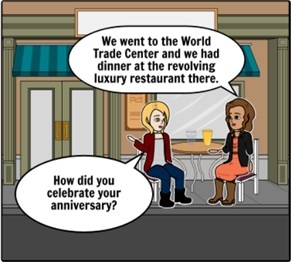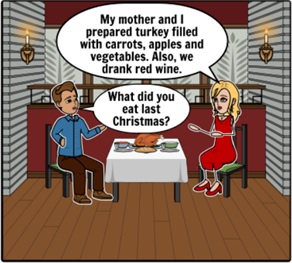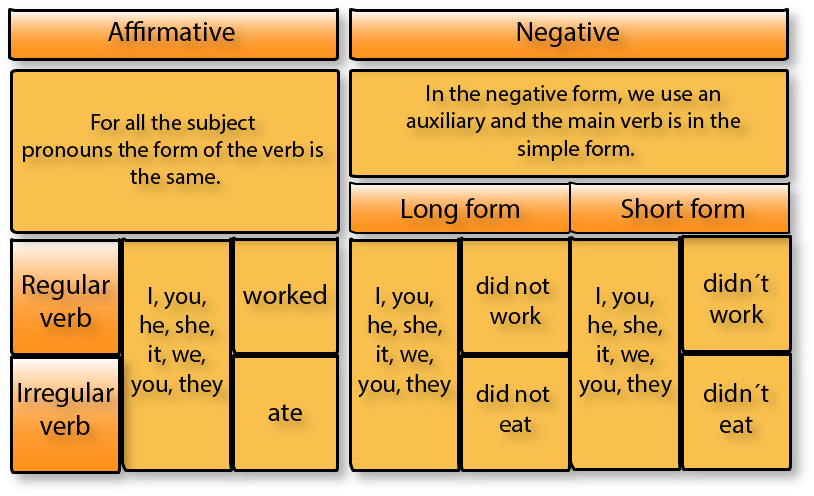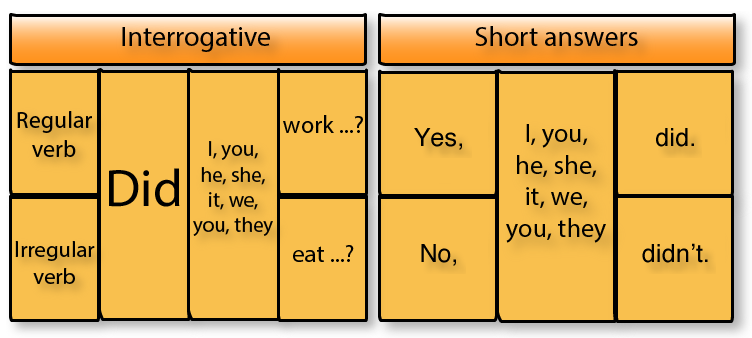Do you like reading?
Think of your favourite writers. Along with this section, you will travel in time, and discover some facts about famous people and the universal feeling known as, love.
At the same time, you will recall old memories.
Start by reading the words of Hermann Hesse, a German author. This legendary is talking to Demian talking about an extraordinary and unexpected feeling.

Habyarimana, B. (2013). Inspirational Quotes For All Occasions. Lulu.com. Retrieved on 2017, February 20 from http://bit.ly/2lYsahs
By the end of this section you will:
Describe specific information by using regular and irregular verbs, through different exercises that deal with past activities and facts about love, events about artists and writers.
We use the simple past for actions which happened or finished in the past.
Look at the examples:


In the previous dialogues, the verbs in the past are: went, prepared and drank. Could you identify which verbs are regular and irregular?
Don't forget that in the simple present we need to change the ending of the verbs for subjects: he, she and it.
It is important to point out that past tense verbs are classified into regular and irregular..
Look carefully at the following chart. Notice the structure of regular and irregular verbs in the affirmative, negative and interrogative form.


Notice that in negative and interrogative sentences the main verb continues in the simple form, it does not change.
When asking for specific information, we use wh-question words at the beginning of a question.
What did you wear for the party? I wore a beautiful red dress and high heels.
How did you know you were soul mates? I don’t know, but when I met him, I knew it.
When did you have your first kiss? Oh, when I was 15 years old.
Where did you celebrate Christmas last year? I celebrated Christmas at my mom’s home.
Why did you react like that? Because I loved her.
Activity 1
Have you already found your soul mate?
Some people would say in the words of a Mexican singer: “I wasn’t born to love,” or "when you have found your soul mate reality hits you and the pieces begin to fit", said British singer.
However, that’s what Isabel Allende said: “Love, like fortune, arrives when it is not asked for. It confuses us, and fades away like fog when we try to grab it”.
Previously, you studied regular and irregular verbs to talk about the past. In the following activity, you will identify personal information as well as past events of three talented writers.
After that, you will read letters where you will change the verbs to the past. In each section, you will find the appropriate instructions.
Once you have read about those writers, read some letters in which you will write verbs in the past. Read what they have written to their lovers.

Hamza Butt. (2017). Love [photo]. Retrieved on 2017, August 11 from http://bit.ly/2uDaei8
Activity 2
This time you will listen to Madonna sing a pop ballad written by her and others lyricists. She is considered by many as the “Queen of Pop.” The song deals with her personal life, fame and love. According to the information studied in the content, you will complete the following activity by filling in the blanks while you listen to her sing, Substitute for love.

choupigloupi. (2007). Madonna [photo]. Retrieved on 2017, August 11 from http://bit.ly/2vCT3dF
Activity 3
Based on previous activities, you may have noticed we need to use regular and irregular verbs in the simple past to talk about past events, facts and even feelings.
Now is your turn to describe an old memory in which you will use regular and irregular verbs in the past.

Takazart. (2008). Couple [photo]. Retrieved on 2017, February 28 from http://bit.ly/2lEtuq4
Some say that love moves the world. Do you remember your first boyfriend or girlfriend? Do you remember your first kiss?
Write a short description about the first time you kissed someone. Take into account the following questions to do your work. Do not forget to use regular and irregular verbs in the simple past. Extension: 60 – 75 words.
How old were you?
• What was his/her name?
• Where were you?
• What did you say?
• What happened in the end?
• How did you feel?
Please, before you send your description, make sure it has the characteristics contained in the rubrics.
Activity 4

Unknow. (n.d.). thought [illustration]
It’s time to talk about your memories. You will record yourself describing that day. It is important to use complete ideas in the past tense, as well as regular e irregular verbs. The audio must last about 40 – 60 seconds.
Choose one topic from the following list. Talk about:
Before recording yourself, check the rubrics below. You will use them to evaluate your progress when you finish the recording.
You can also listen to an example of this activity here.
 Example
ExampleUse the next page to record your audio: Vocaroo.
After having studied this topic and answering the activities, now it’s time to put into practice all that you have learnt.
First, you will have the opportunity to distinguish between regular and irregular verbs.
Then you will practice writing irregular verbs. Remember to follow and practice the rules.
After studying the previous information, identify the mistakes in the following sentences. Finally, write the correct sentences in the spaces.
You have come to the end of this topic, and you have done it well. Remember the importance of using the correct tense, structure and spelling when talking about your memories and feelings of the special moments in your life. Congratulations!
Biografías y Vidas. (2004-2017). Jaime Sabines [website]. Taken from https://www.biografiasyvidas.com/biografia/s/sabines.htm
Biografías y Vidas. (2004-2017). John Keats [website]. Taken from https://www.biografiasyvidas.com/biografia/k/keats.htm
Evans, V. (2001). Click On 1. Workbook. Berkshire, England: Express Publishing.
García, T. (2015). “Los amorosos, Cartas a Chepita” de Jaime Sabines [website]. Taken from https://culturacolectiva.com/los-amorosos-cartas-a-chepita-de-jaime-sabines/
Learn English. (2008). Irregular Verbs [video]. Retrieved on 2017, February 28 from https://www.youtube.com/watch?v=gK12tjcqpsM
Linder, O. D. (2011). Famous trials [website]. Taken from http://law2.umkc.edu/faculty/projects/ftrials/wilde/lettersfromwilde.html
MadonnaNew. (2010, December 2). Madonna – Substitute For Love [video]. Taken from https://www.youtube.com/watch?v=6rsdGjNWiIw
Murphy, R. (1995). English Grammar in Use. Cambridge: Cambridge University Press.
National Portrait Gallery: NPG 197. (circa 1822). John Keats by William Hilton [photo]. Taken from https://bit.ly/2m0Xw84.
Prapti. E. (2016). 15 Steamy Love Letters By Famous Authors That Are Better Than Sexting In Today’s Age [website]. Taken from https://www.scoopwhoop.com/15-Steamy-Love-Letters-By-Famous-Authors-That-Are-Better-Than-Sexting-In-Todays-Age/#.oxkveds86
Sarony, N. (circa 1882). Oscar Wilde portrait by Napoleon Sarony-albumen [photo]. Taken from https://bit.ly/2meRmNM.
Swan, M. (2005). Practical English Usage (3rd ed.). Oxford: Oxford University Press.
Murphy, R. (1995). English Grammar in Use. Cambridge: Cambridge University Press.
Naylor, H. (2007) Essential Grammar in Use, Suplementary Exercises. United Kingdom: Cambridge University Press.